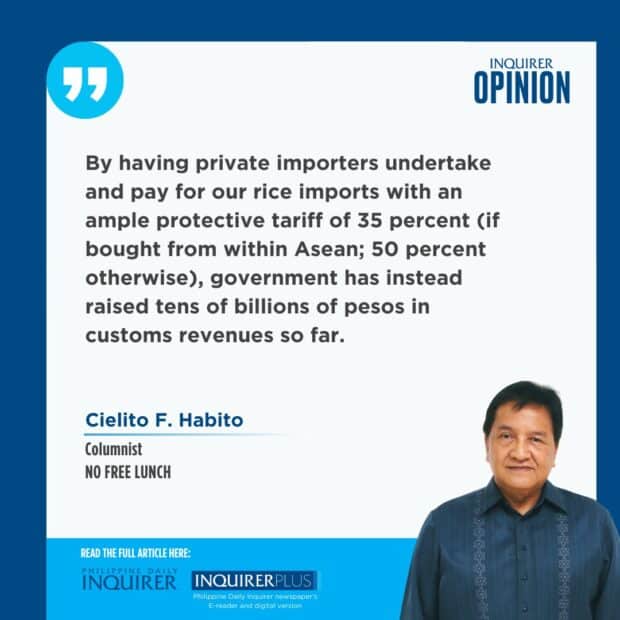Best use of rice funds

A key feature of Republic Act No. 11203 or the rice tariffication law (RTL) that Congress wisely and finally passed in 2019, more than two decades overdue, was how it raised substantial funds to help our rice farmers boost their productivity and competitiveness. It completely reversed the past setup wherein we taxpayers financed all our rice imports done exclusively by a government agency whose huge deficits perennially bled our national coffers since the 1980s. By having private importers undertake and pay for our rice imports with an ample protective tariff of 35 percent (if bought from within Asean; 50 percent otherwise), government has instead raised tens of billions of pesos in customs revenues so far.
Under RTL, these revenues support a Rice Competitiveness Enhancement Fund (RCEF) of P10 billion a year for six years, to be used to help our rice producers improve their productivity and ability to face up to competition from imports. Our lawmakers decided to earmark half of the fund for mechanization support, 30 percent for the development and promotion of inbred seeds, 10 percent for credit financing, and 10 percent for extension services to train farmers, mostly through farm schools supervised by the Technical Education and Skills Development Authority.
But many of us who had pushed for RTL saw this RCEF allocation to be problematic from the start. Having anticipated a drop in farmgate prices following implementation of the law, we argued that the most urgent use for much of the tariff proceeds should be for cash safety nets for small rice farmers hit hard by the resulting price fall. National Scientist Dr. Emil Q. Javier pushed for P20,000 per hectare, and as a close adviser to then Agriculture Secretary William Dar, suggested to him this amount. But Congress chose the above allocation, and allowed farmer cash support only when tariff revenues exceed the annual P10 billion target—thereby making it the last priority use of the funds, rather than the urgent first priority we argued it should have been.
Article continues after this advertisementThat’s now water under the bridge, and the best we can do is evaluate the actual utilization of the RCEF as allocated, then reallocate it as may be implied by results of the midterm evaluation, which the law itself provided for. The Asian Development Bank commissioned the International Rice Research Institute to do this evaluation for the Department of Agriculture, and findings were released late last year. Here are some of the key findings:
On mechanization, which econometric analysis showed to have high potential impact on production, the program was found hampered by low and slow budget utilization. The Philippine Center for Postharvest Development and Mechanization (PhilMech), as main implementer, suffered “birthing pains” that slowed the procurement process. At the end of 2022, only 46 percent of that year’s budget was obligated with zero disbursement, and only 58 percent of the previous year’s budget had been disbursed. All told, the report notes that PhilMech expects to cover only 14 percent of total requirements for rice mechanization at the end of six years. Meanwhile, it also needs to address issues on non-utilization of machines found unsuitable to local conditions, a glaring waste of resources.
The seeds component, on the other hand, received high marks on overall efficiency in meeting its goals. There were issues with late delivery of certified seeds for up to 5 percent of farmer beneficiaries, and inability to reach many deserving farmers due to non-listing in the Registry System for Basic Sectors in Agriculture. This farmer’s registry has issues of its own that merit another discussion, but overall, the RCEF seeds program appeared to be working well. On credit, the report gives the program high marks for budget utilization and achieving targets on loan disbursement rates to farmers. Still, loan repayment rates have been low, and overall impact on yield is found low as well. Overall reach to rice farmers was found limited and skewed to certain regions, and the poorest of farmers are left out as the crop insurance system covers only farms larger than one-fourth hectare. Finally, on training and extension, the report observed frequent repetition in training to particular groups of farmers, rather than widening their reach to more farmers. Lack of an effective monitoring and evaluation system and framework also hampers assessment of the system’s effectiveness in raising farmer capabilities and farm productivity.
Article continues after this advertisementClearly, deeper thinking and focused efforts need to be put into allocating precious funds meant to support the game-changing reform of rice trade liberalization, which ultimately serves the greatest good for the greatest number of Filipinos. But there must be a sense of urgency in providing timely support in the right form to our farmers who need it most.
cielito.habito@gmail.com
















